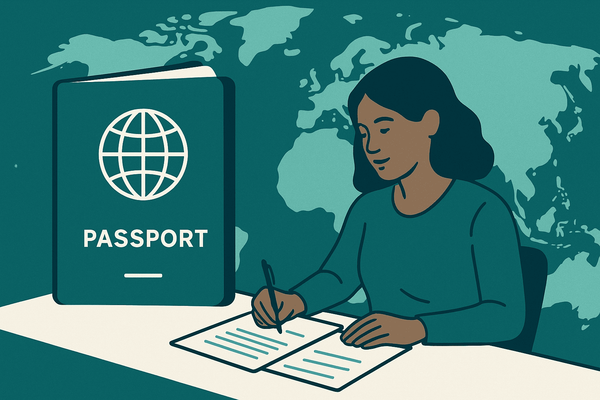Digital Nomad Statistics (2025)

The digital nomad lifestyle is no longer just a trend—it’s a way of life for millions of people around the world. Thanks to remote work, fast internet, and changing work cultures, more professionals than ever are choosing to work from anywhere, whether it’s a beach in Thailand, a café in Portugal, or a cabin in the mountains.
But just how big is this movement? How much do digital nomads earn? Where do they go? And what challenges do they face?
In this article, we’ll dive into the latest 2025 statistics on digital nomads. We’ll explore how many there are, where they live, what jobs they do, how much they spend, and much more.
Global overview of digital nomads
The digital nomad movement has seen remarkable growth in recent years, with more individuals choosing the freedom of working remotely while exploring different parts of the world. As of 2024, there are an estimated 40 million digital nomads worldwide, with 18.1 million hailing from the United States—a significant increase from previous years.
Additionally, more digital nomads are becoming independent workers, with data indicating that 20% were self-employed in 2024, and an increasing number are embracing slow travel to enjoy local culture and experiences.
Economic impact
Digital nomads contribute significantly to the global economy. Collectively, they are estimated to inject nearly $800 million annually, benefiting various sectors such as housing, local services, and coworking spaces.
Factors driving growth
Several key factors have fueled the rise of digital nomadism:
- Expansion of Remote Work Opportunities: The acceptance and implementation of remote work have broadened, allowing more professionals to work from anywhere.
- Technological Advancements: Improved digital infrastructure and widespread internet access make it easier to stay connected globally.
- Desire for Flexibility: Many individuals seek a better work-life balance and the adventure of experiencing new cultures.
- Economic Incentives: Some regions offer financial incentives to attract remote workers, such as Spain’s Ambroz Valley, which offers approximately $16,620 to remote workers willing to relocate for at least two years.
As the world continues to adapt to new ways of working, the digital nomad lifestyle is expected to keep expanding, influencing economies and cultures across the globe.
Here’s the updated and improved version of the Digital Nomad Demographics section, now incorporating Religious & Political Views, Sexual Orientation, Ethnicity, and Educational Background:
Digital nomad demographics
The digital nomad community is more diverse than ever, spanning different age groups, genders, nationalities, and backgrounds.
While tech professionals and entrepreneurs once dominated this space, an increasing number of remote employees and professionals from a variety of industries are embracing the nomadic lifestyle.
Age distribution
The average digital nomad in 2025 is 36 years old, with most falling between 30 and 39 years old.
However, there is significant representation from other age groups as well:
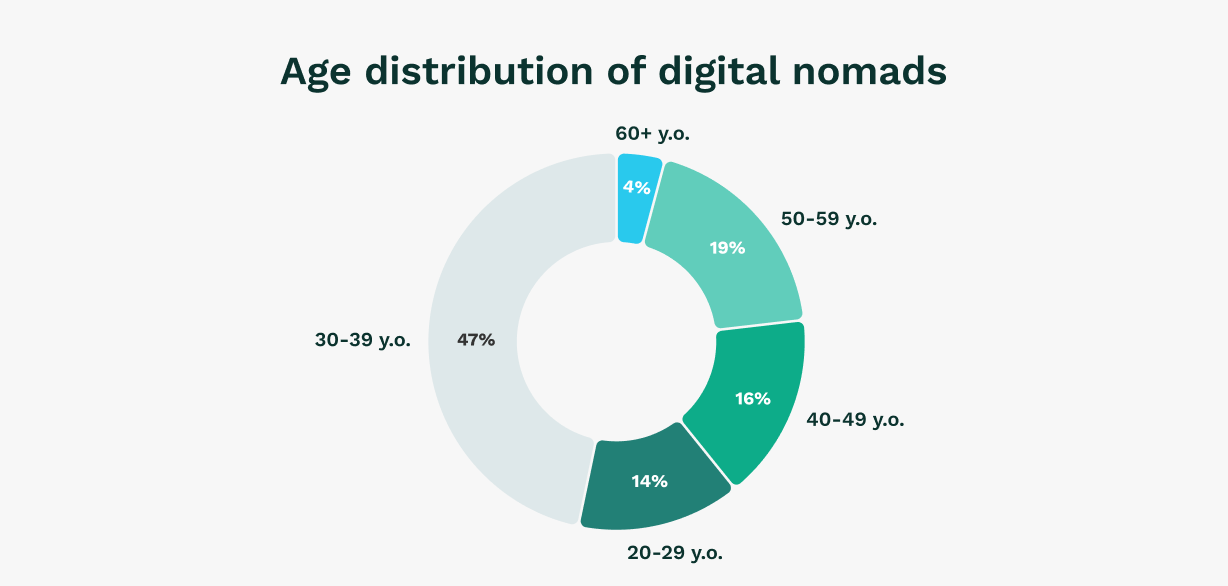
- 30-39 years old → 47% (largest group)
- 20-29 years old → 14%
- 40-49 years old → 16%
- 50-59 years old → 19%
- 60+ years old → 4%
While the majority of digital nomads are in their 30s and 40s, interest in this lifestyle continues to grow among younger professionals and even older generations looking for flexibility in semi-retirement.
Gender breakdown
Despite efforts to create a more balanced workforce, digital nomadism remains a male-dominated space.
However, women’s participation has been steadily increasing:
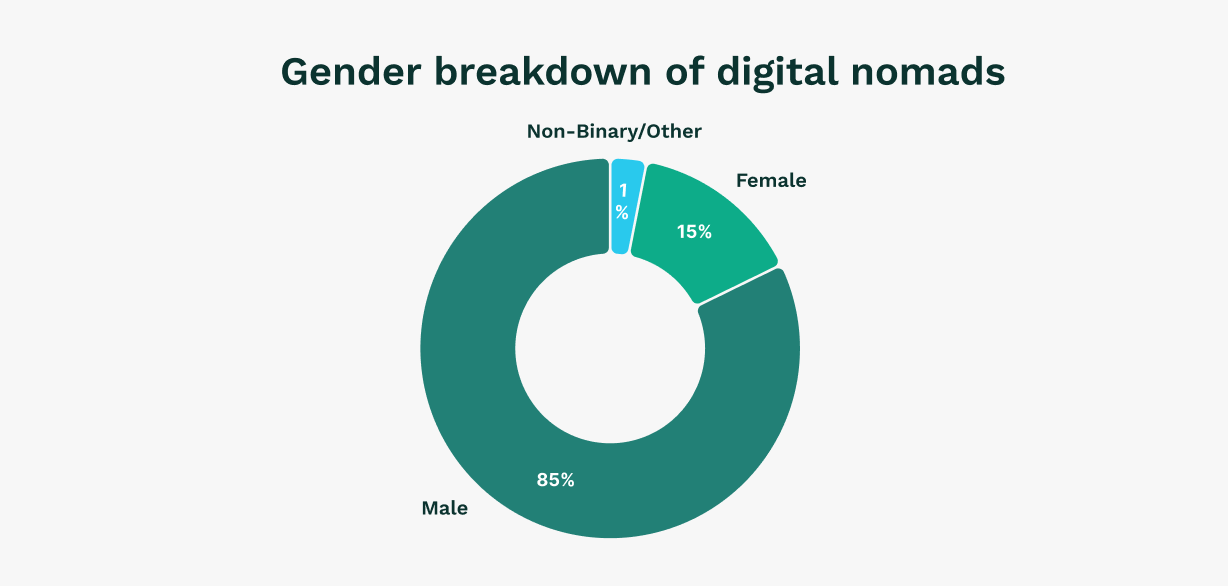
- Male → 85%
- Female → 15%
- Non-Binary/Other → 1%
Although men still make up the vast majority, the number of female digital nomads has grown in the past five years. Initiatives such as remote work mentorship programs and women’s digital nomad communities have played a role in closing the gap.
Sexual orientation
While the majority of digital nomads identify as heterosexual, there is a notable LGBTQ+ presence in the community:
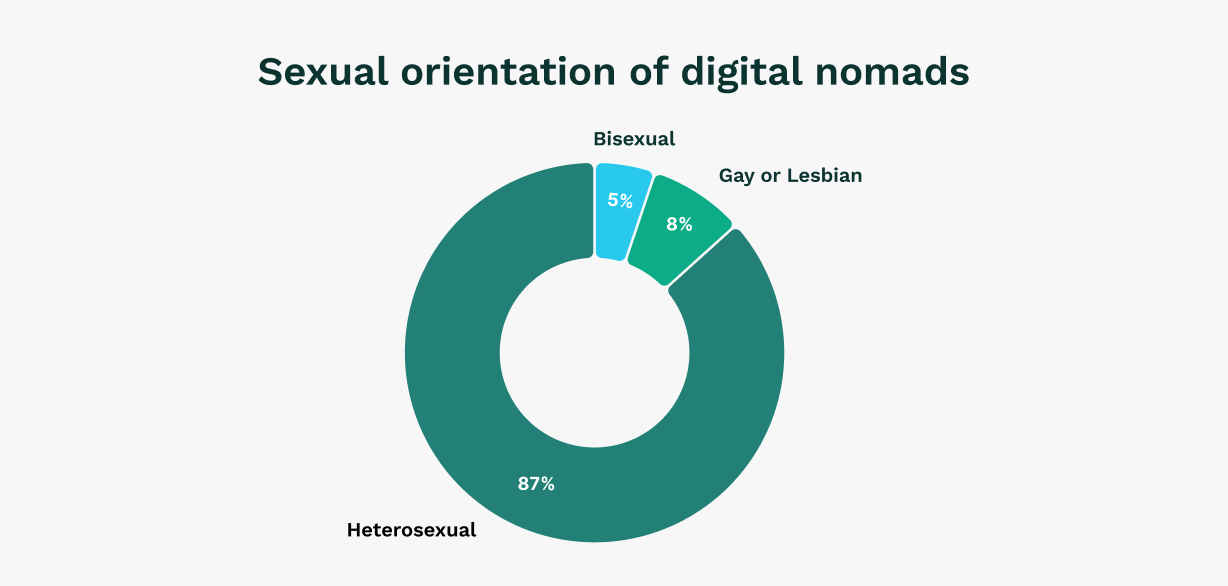
- Heterosexual → 87%
- Bisexual → 8%
- Gay or Lesbian → 5%
This suggests that digital nomadism is an inclusive space, though LGBTQ+ representation is still lower compared to general population statistics in some countries.
Religious & political views
Religious Identification
Digital nomads tend to be more secular than the general population, with 53% identifying as not religious.
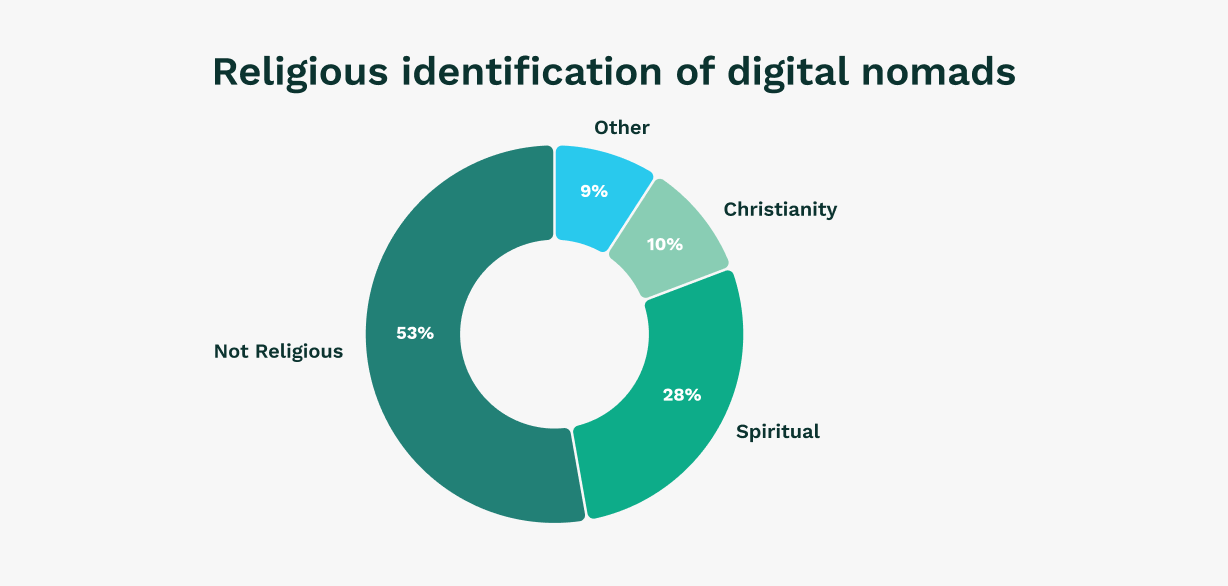
- Not Religious → 53%
- Spiritual (but not religious) → 28%
- Christianity → 9%
- Other (Buddhism, Islam, Judaism, etc.) → 10%
Political leanings
The political views of digital nomads vary, but gender differences are significant:
- 46% of male digital nomads identify as progressive.
- 72% of female digital nomads identify as progressive.
Ethnicity & diversity
While white individuals still make up the majority of digital nomads (59%), representation from diverse ethnic backgrounds is growing:
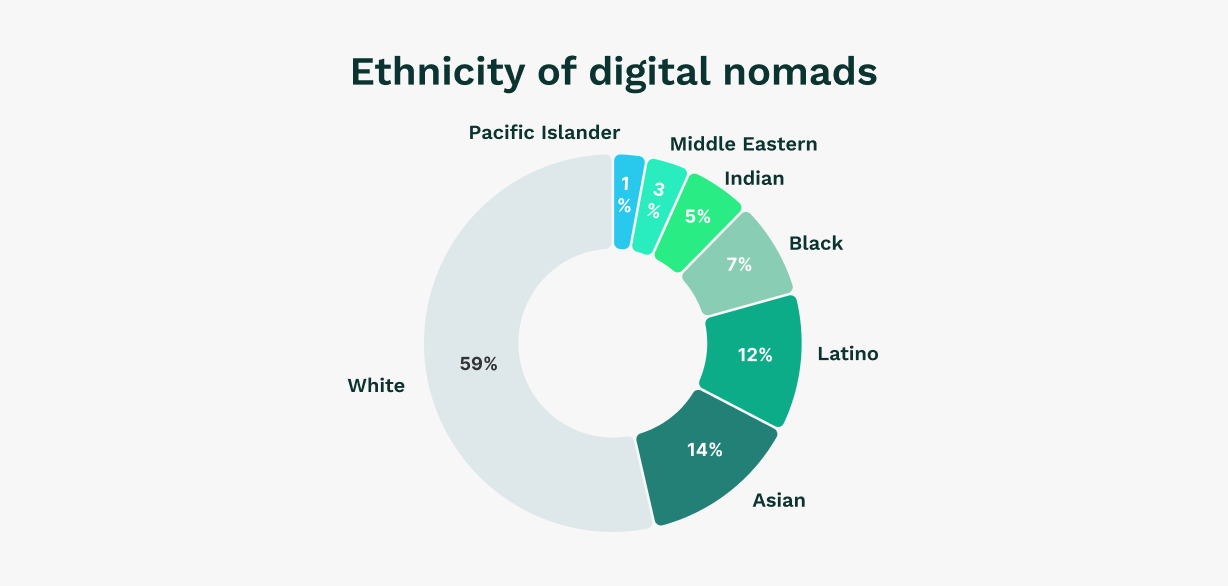
- White → 59%
- Asian → 14%
- Latino → 12%
- Black → 7%
- Indian → 5%
- Middle Eastern → 3%
- Pacific Islander → 1%
Educational background
Most digital nomads have higher education degrees, reflecting the professional skill sets required for remote work.
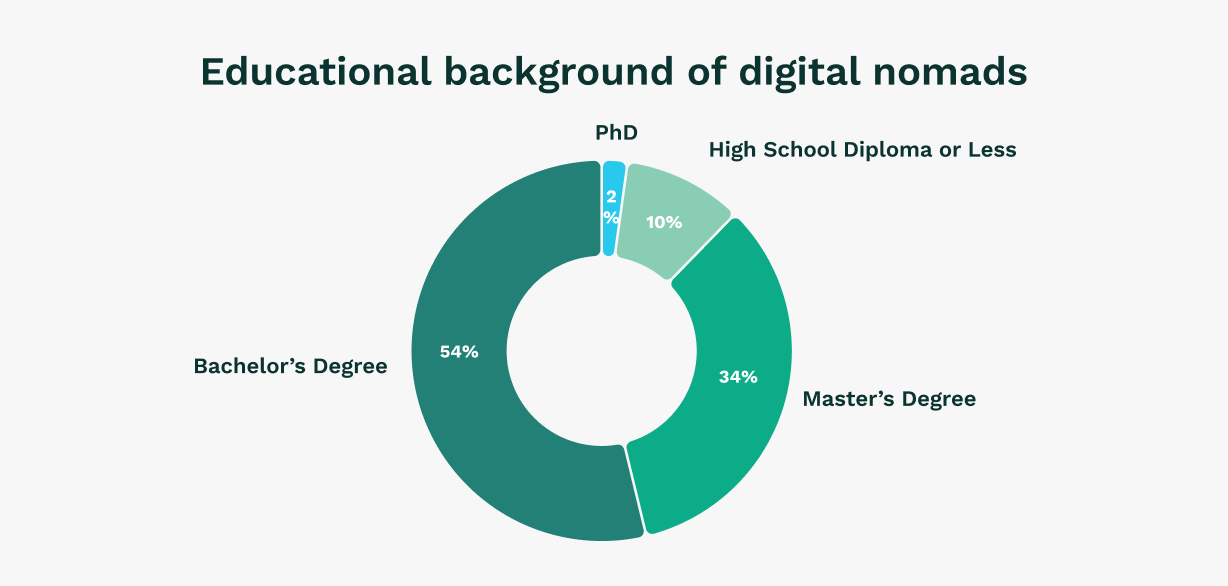
- Higher Education → 90%
- Bachelor’s Degree → 54%
- Master’s Degree → 34%
- PhD → 3%
- High School Diploma or Less → 10%
This high level of education reflects the fact that most digital nomads work in highly skilled fields, such as software development, marketing, consulting, and design. However, new opportunities in e-commerce, teaching, and creative industries are making the lifestyle more accessible to those without formal higher education.
Geographical distribution
Digital nomadism has traditionally been dominated by individuals from English-speaking countries, but other regions are catching up. The top 10 countries of origin for digital nomads in 2025 are:
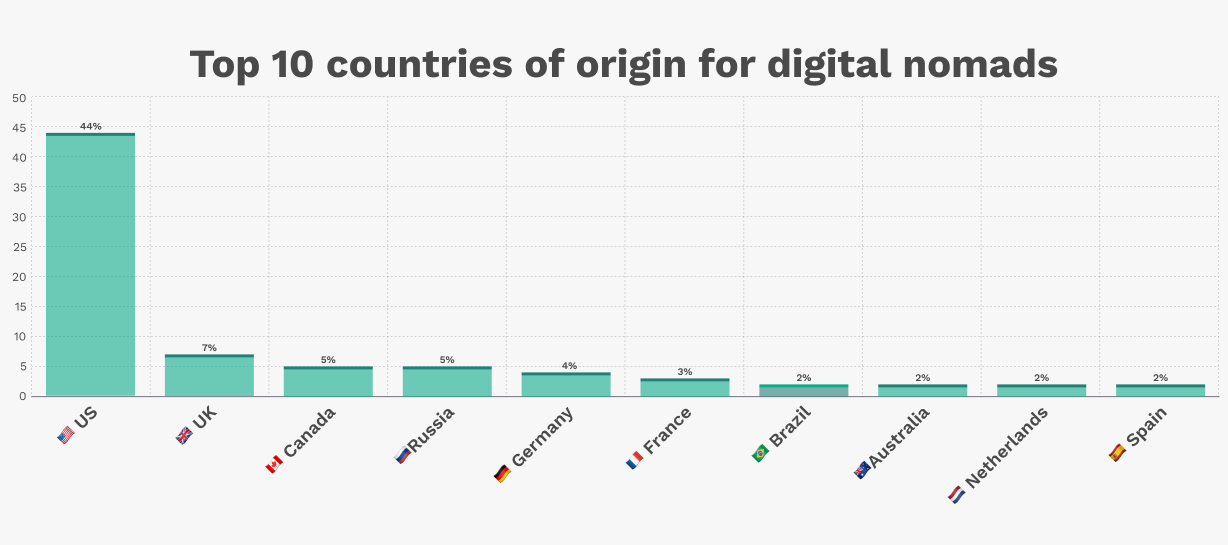
- United States → 44%
- United Kingdom → 7%
- Canada → 5%
- Russia → 5%
- Germany → 4%
- France → 3%
- Brazil → 2%
- Australia → 2%
- Netherlands → 2%
- Spain → 2%
While nearly half of digital nomads still come from the United States, countries in Europe and Latin America are beginning to see higher participation rates, thanks to improved remote work infrastructure and favorable visa policies.
Employment and income
The digital nomad landscape in 2025 showcases a diverse array of employment types, income levels, and professions. This diversity reflects the adaptability and broad appeal of the nomadic lifestyle across various sectors.
Employment type
Digital nomads working engage in a variety of work arrangements, with notable variability in their income levels:
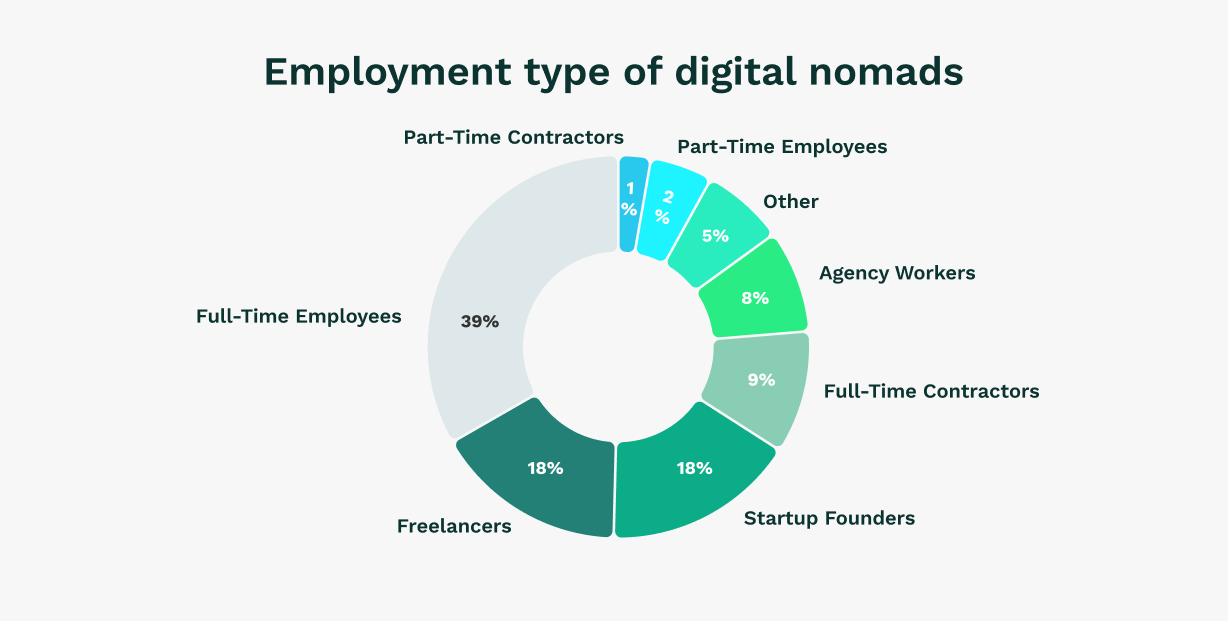
- Full-Time Employees: 39%
- Freelancers: 18%
- Startup Founders: 18%
- Full-Time Contractors: 9%
- Agency Workers: 8%
- Other: 5%
- Part-Time Employees: 2%
- Part-Time Contractors: 1%
Contrary to the common perception of digital nomads primarily being freelancers, a significant portion hold full-time positions, underscoring the acceptance of remote work in traditional employment structures.
Income Levels
Earnings among digital nomads vary widely:
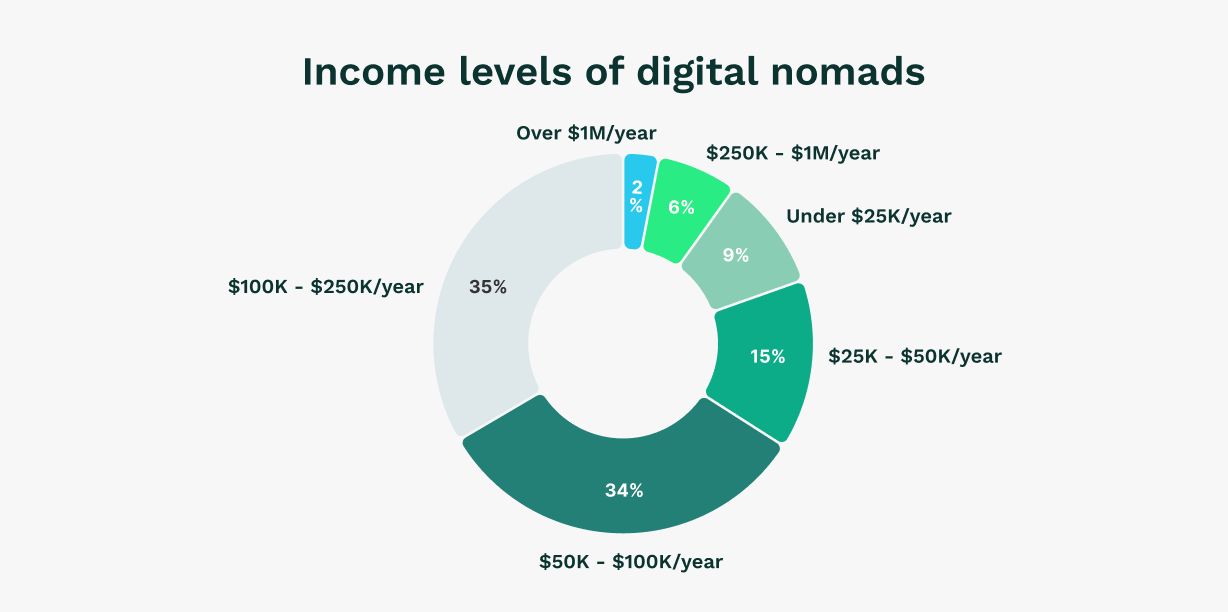
- Under $25,000/year: 6%
- $25,000 - $50,000/year: 15%
- $50,000 - $100,000/year: 34%
- $100,000 - $250,000/year: 35%
- $250,000 - $1,000,000/year: 9%
- Over $1,000,000/year: 2%
The average annual income is approximately $124,041, with a median income of $85,000. Many digital nomads reported reinvesting their income back into their businesses, focusing on long-term growth rather than immediate savings.
This distribution indicates that while many digital nomads achieve substantial earnings, a considerable number maintain moderate income levels, reflecting the varied nature of remote work opportunities.
Popular professions
Digital nomads occupy roles across multiple industries, with a strong presence in technology and creative fields:
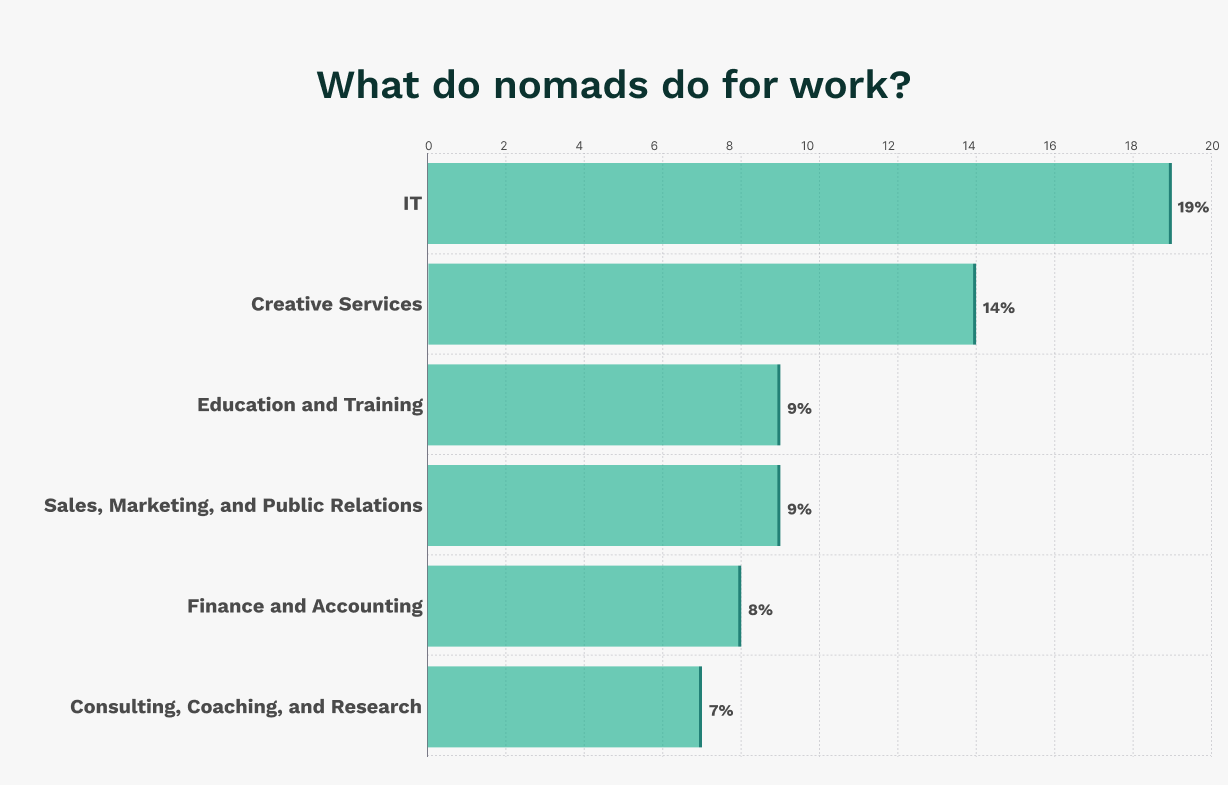
- Information Technology (IT): 19%
- Creative Services: 14%
- Education and Training: 9%
- Sales, Marketing, and Public Relations: 9%
- Finance and Accounting: 8%
- Consulting, Coaching, and Research: 7%
Preferred destinations
Digital nomads in 2025 continue to seek destinations that balance affordability, reliable internet, cultural experiences, and supportive visa policies.
Most popular digital nomad cities (2025)
Based on user rankings and reported visits, the top most visited cities by digital nomads in 2025 are:
- Mexico City, Mexico 🇲🇽 – Affordable, vibrant culture, strong community
- Tokyo, Japan 🇯🇵 – Tech-friendly, excellent infrastructure, safe
- Tbilisi, Georgia 🇬🇪 – Affordable, fast-growing hub, visa-free stays for 365 days
- Madrid, Spain 🇪🇸 – Cultural hub, good infrastructure, digital nomad visa available
- Paris, France 🇫🇷 – Rich cultural scene, major international hub
- Seoul, South Korea 🇰🇷 – Ultrafast internet, efficient public transport, new digital nomad visa
- Warsaw, Poland 🇵🇱 – Budget-friendly, strong startup ecosystem
- Munich, Germany 🇩🇪 – Well-developed, high quality of life, strong economy
- Athens, Greece 🇬🇷 – Sunny climate, affordable lifestyle, emerging hub
- Porto, Portugal 🇵🇹 – Cheaper than Lisbon, scenic, growing community .
These cities rank high due to low cost of living, availability of remote work infrastructure, safety, and growing nomad communities.
Most visited countries by digital nomads (2025)
Here are the top countries digital nomads are choosing based on reported visits:
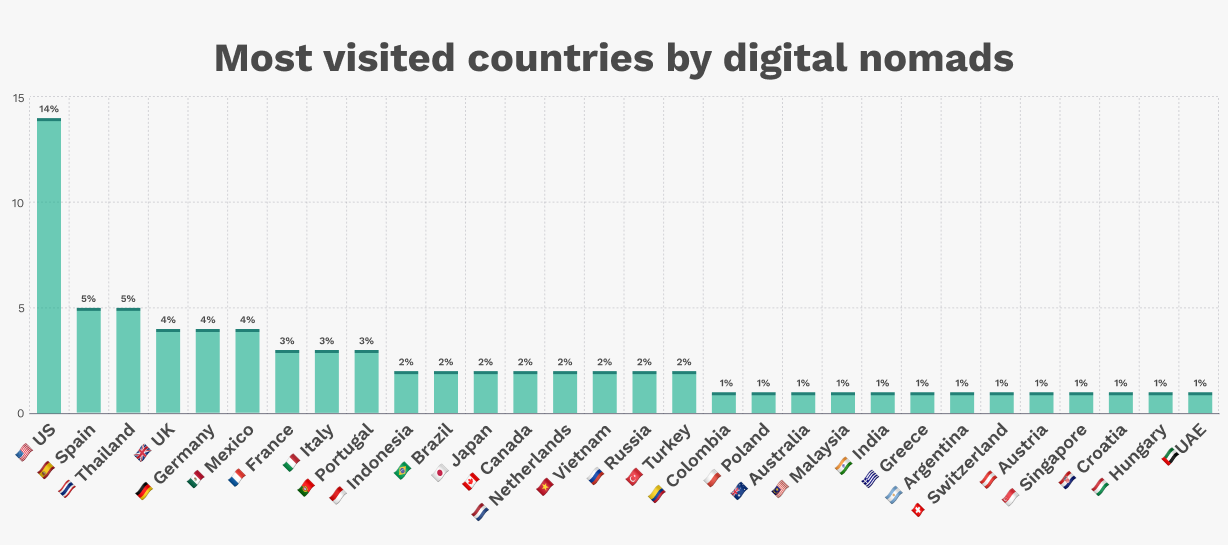
- United States 🇺🇸 – 14%
- Spain 🇪🇸 – 5%
- Thailand 🇹🇭 – 5%
- United Kingdom 🇬🇧 – 4%
- Germany 🇩🇪 – 4%
- Mexico 🇲🇽 – 4%
- France 🇫🇷 – 3%
- Italy 🇮🇹 – 3%
- Portugal 🇵🇹 – 3%
- Indonesia 🇮🇩 – 2% .
Best digital nomad visa programs in 2025
Governments worldwide are introducing dedicated digital nomad visas to attract remote workers. Some of the best programs in 2025 include:
- Portugal – Digital Nomad Visa (D7), leading to residency after 5 years.
- Spain – Digital Nomad Visa (valid for 1 year, renewable for 5 years).
- Estonia – The first country to launch an official digital nomad visa.
- Colombia – 2-year visa, low income requirement ($900/month).
- Thailand – New Long-Term Resident Visa (LTR), allowing up to 10 years for high-income earners.
- South Korea – New 2-year digital nomad visa, ideal for tech professionals.
- Mexico – Temporary resident visa for up to 4 years for remote workers .
These visa programs make long-term stays easier for remote workers while providing a legal framework for residence.
Lifestyle and work habits
The digital nomad lifestyle in 2025 is shaped by new work preferences, technology adoption, and housing choices.
Work environment
Where digital nomads work from
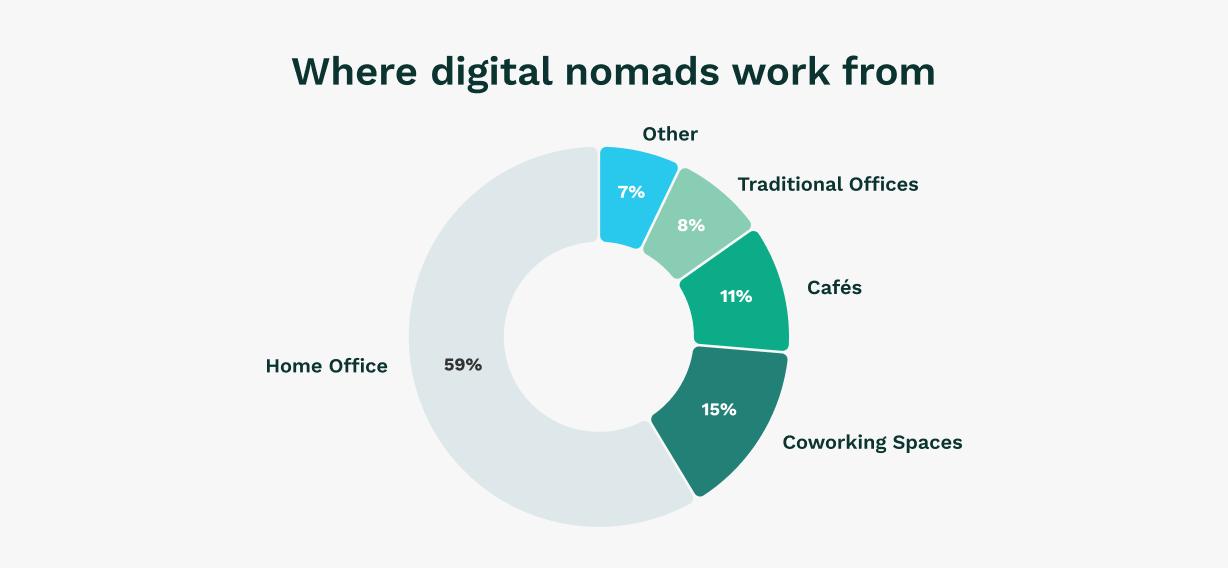
- Home Office → 59% prefer working from home or their Airbnb/rental.
- Coworking Spaces → 15% enjoy working in coworking spaces, valuing networking opportunities.
- Cafés → 8% work from local cafés for the ambiance.
- Traditional Offices → 7% still maintain access to physical offices.
- Other → 11% work from various locations, including balconies, libraries, vans, and boats.
Average working hours
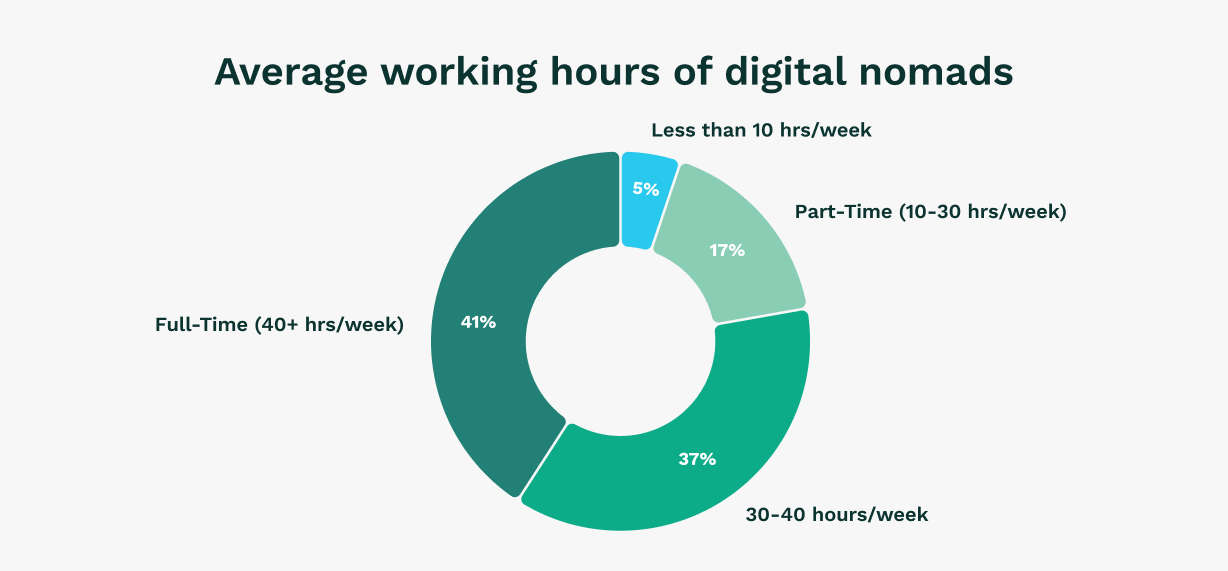
- Full-Time (40+ hrs/week) → 41%
- 30-40 hours/week → 37%
- Part-Time (10-30 hrs/week) → 17%
- Less than 10 hrs/week → 5%
Most digital nomads work full-time but enjoy the flexibility of remote work, allowing them to adjust their schedules to accommodate travel and personal interests.
Duration of nomadic lifestyle
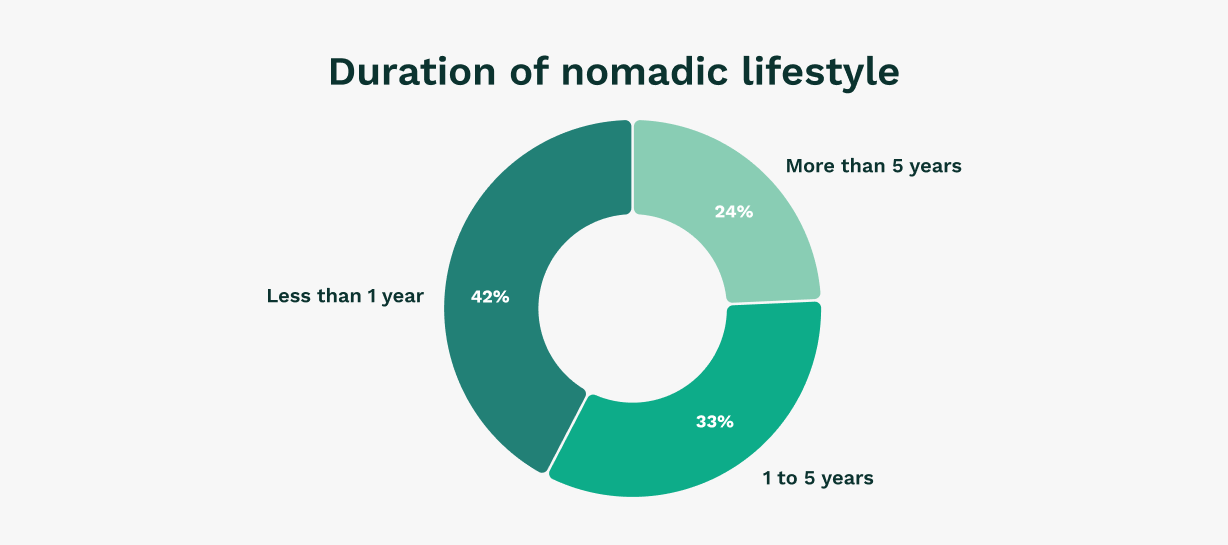
- Less than 1 year → 42%
- 1 to 5 years → 33%
- More than 5 years → 24%
While many are new to the digital nomad lifestyle, a significant portion has sustained it for over five years, demonstrating that nomadism is more than just a short-term experience for many.
Technology usage
Most used messaging apps among digital nomads
A recent survey of 5,256 digital nomads found that Telegram and WhatsApp are the most popular messaging apps, while Slack and Facebook Messenger are rarely used:
- Telegram → 48%
- WhatsApp → 42%
- Twitter → 5%
- Snapchat → 2%
- Facebook Messenger → 2%
Essential digital tools & platforms
To maintain productivity, digital nomads rely on various tools:
- Communication → Telegram, WhatsApp, Google Chat, Zoom
- Project Management → Asana, Trello, Notion
- Cybersecurity → VPN usage is widespread due to concerns about data privacy
- AI & Automation → Growing use of AI for content creation, workflow automation, and customer support .
Community and networking
How digital nomads stay connected
- Online groups & social media → Active communities on Reddit, Facebook groups, and Nomad List forums.
- Local nomad meetups & events → Major hubs like Lisbon, Bali, and Mexico City host regular networking events.
- Coworking & coliving spaces → Nomads use coworking spaces for collaboration and social connections .
Why networking matters
- Collaboration opportunities → Many nomads find freelance work and business partners through networking.
- Social & mental health → Isolation is a major challenge, and community engagement helps prevent burnout.
- Knowledge sharing → Nomads share tips on visas, taxes, and cost-of-living recommendations.
Housing & homeownership trends
Do digital nomads own homes?
Surprisingly, a majority of digital nomads (54%) are homeowners, contradicting the stereotype that all nomads are long-term renters:
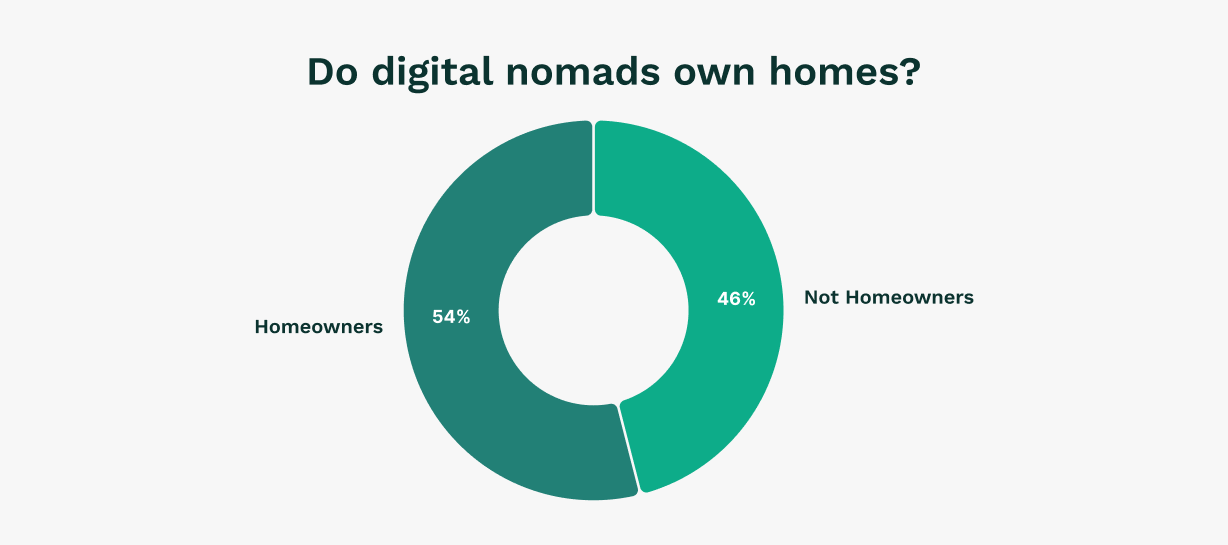
- Homeowners → 54%
- Not homeowners → 46%
While some rent out their properties while traveling, others use homeownership as a base for long-term remote work.
Health, fitness & well-being
How digital nomads stay active
- Hiking → 51% of women, 48% of men
- Yoga → 44% of women, 21% of men
- Fitness/Gym → 40% of women, 49% of men
- Swimming, Running, Cycling → Common among both genders.
Diet & eating habits
- Meat Eaters → 76% of men, 57% of women
- Vegetarians/Vegans → 23% of women, 14% of men
- Pescatarians → 5% of total nomads
- Food Preferences → Nomads prefer local cuisine but often adapt to globalized diets while traveling.
Challenges and considerations for digital nomads in 2025
The digital nomad lifestyle offers flexibility and adventure, but it also comes with unique challenges. Many nomads face financial instability, work-life balance struggles, connectivity issues, and social isolation. These obstacles can affect both productivity and well-being, making it essential to prepare for them in advance.
Below is a structured overview of the key challenges faced by digital nomads, categorized for better readability and practical insights.
Social and mental health challenges
Loneliness and Isolation
- 45% of digital nomads report feeling lonely or isolated.
- 24% experience frequent loneliness due to frequent relocations.
Why it happens:
- Difficulty maintaining long-term friendships due to constant travel.
- Lack of deep social connections with locals or other nomads.
How to manage it:
- Join coliving communities to build deeper connections.
- Participate in local meetups, coworking spaces, and networking events.
- Stay connected through digital nomad forums and social media groups.
Work and productivity challenges
Work-life balance
25% of digital nomads struggle with separating work from personal life.
Common issues:
- No clear boundaries between work and leisure.
- Overworking due to irregular schedules and time zones.
How to manage it:
- Set fixed work hours and schedule regular breaks.
- Use productivity tools like Notion and Asana for structured planning.
- Create a dedicated workspace separate from relaxation areas.
Time zone management
30% of digital nomads have difficulties coordinating across different time zones.
Common issues:
- Scheduling meetings across multiple time zones is challenging.
- Delayed responses affect team collaboration and project deadlines.
How to manage it:
- Use time zone management tools.
- Establish asynchronous work strategies with clear deadlines.
Connectivity and infrastructure challenges
Internet reliability issues
52% of digital nomads cite finding stable Wi-Fi as a major concern.
Common issues:
- Slow or unreliable internet in remote locations.
- Dependence on public Wi-Fi, which increases cybersecurity risks.
How to manage it:
- Invest in portable Wi-Fi devices or local SIM cards.
- Research coworking spaces and accommodations with high-speed internet.
- Use VPNs for secure connections when accessing sensitive data.
Travel logistics
25% of digital nomads find travel planning and logistics overwhelming.
Common issues:
- Managing visa applications and renewals.
- Unexpected travel expenses and accommodation costs.
How to manage it:
- Plan travel in longer stays to reduce visa stress and moving costs.
- Use travel credit cards for rewards and discounts.
- Keep a backup plan in case of travel disruptions.
Financial and career stability
Income stability and budgeting
Many digital nomads, especially freelancers, face income fluctuations.
Common issues:
- Irregular payments make budgeting difficult.
- Banking fees and currency exchange rates reduce earnings.
How to manage it:
- Diversify income streams (freelancing, remote jobs, passive income).
- Use digital banks like Wise or Revolut to minimize fees.
- Maintain an emergency fund for unexpected expenses.
Work uncertainty and career growth
Some nomads struggle to find stable long-term remote work.
Common issues:
- Difficulty securing consistent clients or remote contracts.
- Fewer opportunities for career advancement in some industries.
How to manage it:
- Upskill through online courses to stay competitive.
- Network in remote work communities for job opportunities.
- Consider part-time consulting or coaching for additional income.
Safety and healthcare challenges
Personal safety and security
34% of digital nomads worry about safety while traveling.
Common risks:
- Theft or scams targeting travelers.
- Unfamiliarity with safe neighborhoods or emergency services.
How to manage it:
- Stay in secure accommodations with good reviews.
- Research safe digital nomad destinations before moving.
- Use travel insurance to cover lost items and emergency evacuations.
Healthcare and Insurance
Finding quality healthcare abroad is a challenge for many digital nomads.
Common issues:
- High medical costs without proper insurance.
- Limited access to English-speaking doctors.
How to manage it:
- Purchase global health insurance (e.g., SafetyWing, Cigna Global).
- Use telemedicine services for remote medical consultations.
Family and long-term considerations
Family responsibilities
26% of digital nomads have children under 18 but choose not to travel with them due to schooling challenges.
Common concerns:
- Finding quality education options while moving frequently.
- Lack of stability for family routines and social development.
How to manage it:
- Enroll children in online or international schooling programs.
- Choose long-term stays in cities with strong education systems.
Why some digital nomads quit
Many nomads eventually return to a more settled lifestyle. The most common reasons include:
- Fatigue from constant travel and visa renewals.
- High cost of living in certain destinations.
- Difficulty balancing work and travel effectively.
- Persistent loneliness or missing family and friends.
This article is based on data from Nomads Embassy, Bunq Blog, Radical Storage, Timeout, Nomad Capitalist, Demand Sage, The Nomad Almanac, Howdy, Robin Waite, Localyze, Skyscanner, Cloudwards, Everki Stories, Digital Nomads World, and Nomads.com.



